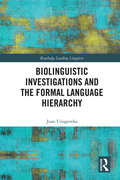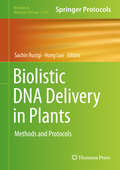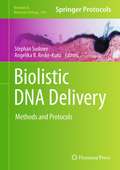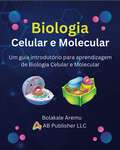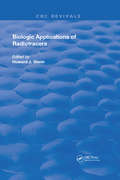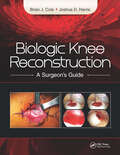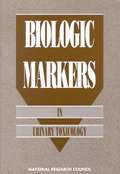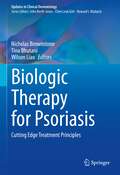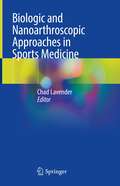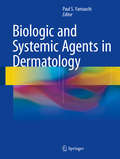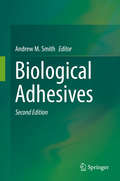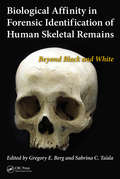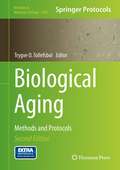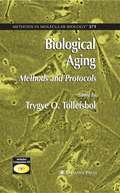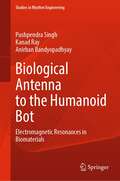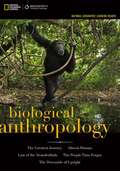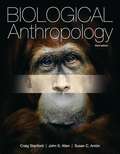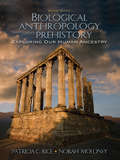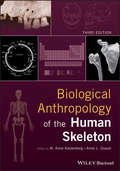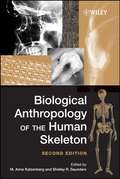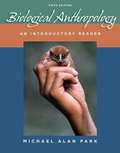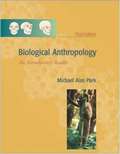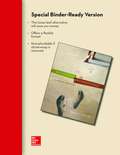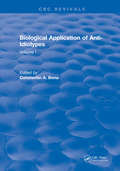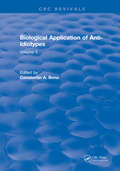- Table View
- List View
Biolinguistic Investigations and the Formal Language Hierarchy (Routledge Leading Linguists)
by Juan UriagerekaThis volume collects some of Juan Uriagereka’s previously published pieces and presentations on biolinguistics in recent years in one comprehensive volume. The book’s introduction lays the foundation for the field of biolinguistics, which looks to integrate concepts from the natural sciences in the analysis of natural language, situating the discussion within the minimalist framework. The volume then highlights eight of the author’s key papers from the literature, some co-authored, representative of both the architectural and evolutionary considerations to be taken into account within biolinguistic research. The book culminates in a final chapter showcasing the body of work being done on biolinguistics within the research program at the University of Maryland and their implications for interdisciplinary research and future directions for the field. This volume is essential reading for students and scholars interested in the interface between language and the natural sciences, including linguistics, syntax, biology, archaeology, and anthropology.
Biolistic DNA Delivery in Plants: Methods And Protocols (Methods In Molecular Biology Ser. #2124)
by Hong Luo Sachin RustgiThis volume details protocols for the use of the biolistic DNA delivery method in different plant species. Chapters guide readers through non-protocol chapters that cover relevant topics of interest, a broad overview of the field, exciting modifications of the system, and reliable plant transformation procedures in different plant species. Written in the highly successful Methods in Molecular Biology series format, chapters include introductions to their respective topics, lists of the necessary materials and reagents, step-by-step, readily reproducible laboratory protocols, and tips on troubleshooting and avoiding known pitfalls. Authoritative and cutting-edge, Biolistic DNA Delivery: Methods and Protocols aims to provide a comprehensive collection of protocols to intended to be a practical guide for the novice as well as the advanced user in the field of plant genetic transformation.
Biolistic DNA Delivery: Methods and Protocols (Methods in Molecular Biology #940)
by Angelika B. Reske-Kunz Stephan SudoweBiolistic transfection represents a direct physical gene transfer approach in which nucleic acids are precipitated on biologically inert high-density microparticles (usually gold or tungsten) and delivered directly through cell walls and/or membranes into the nucleus of target cells by high-velocity acceleration using a ballistic device such as the gene gun. Biolistic DNA Delivery: Methods and Protocols provides a comprehensive collection of detailed protocols intended to provide the definitive practical guide for the novice as well as for the advanced gene transfer expert on how to introduce nucleic acids into eukaryotic cells using the biolistic technique. Split into six convenient sections, this detailed volume covers biolistic gene transfer into plants, nematodes, and mammalian cells, both in vitro and in vivo, as well as the use of gene gun-mediated DNA vaccination in various experimental animal models of human diseases, and the description of biolistic delivery of molecules other than nucleic acids. Written in the highly successful Methods in Molecular BiologyTM series format, chapters include introductions to their respective topics, lists of the necessary materials and reagents, step-by-step, readily reproducible laboratory protocols, and tips on troubleshooting and avoiding known pitfalls. All-inclusive and cutting-edge, Biolistic DNA Delivery: Methods and Protocols brings together the knowledge and the experience of leading experts in the field of gene transfer in order to serve all researchers who wish to further our abilities in this vital field.
Biologia Celular e Molecular: Um guia introdutório para aprendizagem de Biologia Celular e Molecular
by Bolakale AremuEste livro foi elaborado para estudantes que desejam aprender e apreciar tópicos biológicos básicos enquanto estudam as menores unidades da biologia: moléculas e células. A biologia molecular e celular é uma disciplina dinâmica. Existem milhares de oportunidades nas áreas médica, farmacêutica, agrícola e industrial. Além de prepará-lo para uma diversidade de planos de carreira, a compreensão da biologia molecular e celular o ajudará a tomar decisões acertadas que podem beneficiar sua dieta e saúde. Nossos escritores, colaboradores e editores são altamente qualificados em ciências e humanidades, com ampla experiência em ensino e pesquisa em sala de aula. Eles são especialistas na preparação de alunos para testes padronizados, bem como em treinamento de admissão em graduação e pós-graduação. Dê uma olhada no índice: Capítulo 1. Por que estudar biologia celular e molecular? Capítulo 2: O Estudo da Evolução Capítulo 3: O que é Biologia Celular? Capítulo 4: Genética e nossos projetos genéticos Capítulo 5: Conhecendo os Átomos Capítulo 6. Como as ligações químicas combinam átomos Capítulo 7: Água, Soluções e Misturas Capítulo 8 : Quais elementos estão nas células? Capítulo 9: Macromoléculas são as “grandes” moléculas dos seres vivos Capítulo 10: Termodinâmica em Coisas Vivas Capítulo 11: ATP como “Combustível” Capítulo 12: Metabolismo e Enzimas na Célula Capítulo 13: A diferença entre células procarióticas e eucarióticas Capítulo 14: A Estrutura de uma Célula Eucariótica Capítulo 15: A Membrana Plasmática: O Guardião da Célula Capítulo 16: Difusão e Osmose Capítulo 17: Transporte Passivo e Ativo Capítulo 18: Transporte em massa de moléculas através de uma membrana Capítulo 19: Sinalização Celular Capítulo 20: Oxi
Biologic Applications of Radiotracers (Routledge Revivals)
by Howard J. GlennFirst published in 1982: This present volume presents an excellent amount of animal Models in radiotracer investigations, describes the animal radiopharmacology laboratory, and discusses radiotracer distribution differences between species.
Biologic Knee Reconstruction: A Surgeon's Guide
by Joshua Harris Brian ColeTreatment of articular cartilage pathology in the knees of young and active patients is a challenging and controversial issue. Biologic Knee Reconstruction: A Surgeon's Guide is a how-to, step-by-step guide that addresses the evaluation and management of this unique patient population. Internationally renowned cartilage experts Dr. Brian J. Cole and Dr. Joshua D. Harris, along with their contributors, present information on normal and abnormal history and physical examination. The reader will learn proper decision-making using a patient-centered approach of treatment, increasing the likelihood of a successful outcome. In addition to radiographic assessment of articular cartilage, Biologic Knee Reconstruction discusses the use of biomarkers, defect classification, and patient-reported and surgeon-measured outcomes. Aggressive nonsurgical medical management, including medications, injections, physiotherapy, and rehabilitation, is also presented.Biologic Knee Reconstruction also discusses the management of concomitant pathologies such as malalignment, meniscal deficiency, and ligamentous instability. Selection of surgical cartilage restorative treatment options is multifactorial, requiring consideration of several patient-, knee-, and defect-specific issues. All contemporary open and arthroscopic cartilage techniques are presented in detail with high resolution figures. A unique feature of Biologic Knee Reconstruction is the presentation of several chapters discussing non-medical issues highly pertinent to the advancement and future of this field: funding of research and cost of new advanced technologies, regulation of advanced cellular, tissue, and genetic technologies, evidence-based medicine and clinical trial design and conduct, and the ethics of allograft tissues and stem cell use.Features: Technique preference cards from the experts performing cartilage surgery Patient education information The most up-to-date descriptions of advanced cartilage techniques Unique chapters not covered in books elsewhere, including: Biomarkers Patient-reported outcomes assessment Newer injection techniques (PRP, stem cells) One- and two-stage open and arthroscopic techniques using chondrocyte- and stem cell based cell therapies Costs and public and private funding of research Barriers to high-quality randomized trials Governmental regulation and availability/accessibility to patients Gene therapy and tissue engineering Ethics of articular cartilage surgery with stem cells, ex-vivo cell manipulation, and juvenile tissue sources With the most up-to-date content and step-by-step methods for surgical procedures, Biologic Knee Reconstruction: A Surgeon's Guide is the perfect addition to the bookshelf of the orthopedic surgeon, cartilage researcher, sports physical therapist, or athletic trainer who evaluates and manages this unique patient population.
Biologic Markers in Urinary Toxicology
by Subcommittee on Biologic Markers in Urinary ToxicologyDiseases of the kidney, bladder, and prostate exact an enormous human and economic toll on the population of the United States. This book examines prevention of these diseases through the development of reliable markers of susceptibility, exposure, and effect and the promise that new technologies in molecular biology and sophisticated understanding of metabolic pathways, along with classical approaches to the study of nephrotoxicants and carcinogens, can be developed and prevention of the diseases achieved. The specific recommendations included in this book complement those made in the previous three volumes on biomarkers, Biologic Markers in Reproductive Toxicology (1989), Biologic Markers in Pulmonary Toxicology (1989), and Biologic Markers in Immunotoxicology (1991).
Biologic Therapy for Psoriasis: Cutting Edge Treatment Principles (Updates in Clinical Dermatology)
by Tina Bhutani Wilson Liao Nicholas BrownstoneBiologic therapy is a treatment that strives to modulate a patient's immune system to fight a given disease. In psoriasis, a skin disorder that is partly caused by a dysregulated immune system resulting in well-demarcated red areas of the skin with white scales, biologic therapy has the potential to vastly improve upon patient outcomes by minimizing the symptoms of this disease while maximizing the safety profile of the therapy. This book offers an up-to-date and comprehensive review on biologic therapy for the treatment of psoriasis. With over 10 FDA approved biologic agents for psoriasis (with more in the pipeline), confusion exists among providers regarding which agent is best for a particular patient. Chapters cover all FDA approved psoriasis biologic agents (including pipeline agents) for use in pediatric, adult, and geriatric patients. This book is unique in that it will not only cover cutting edge treatment principles based on the latest research, it will also be one of the most comprehensive reviews of psoriasis biologics in the COVID-19 era. Biologic Therapy for Psoriasis is a must-have resource for board certified dermatologists and rheumatologists, dermatology and rheumatology residents and fellows, dermatology physician assistants, nurse practitioners and medical students. The ultimate goal of this book is to improve patient care by making the busy practicing dermatology provider more adept with these particular therapies.
Biologic and Nanoarthroscopic Approaches in Sports Medicine
by Chad LavenderIn recent years, there have been a number of exciting advances in biologic and nanoarthroscopic approaches in sports medicine, giving the clinician even more options for safe and effective minimally invasive treatments for the active patient. This practical text presents these breakthrough techniques in detail and describes the authors' experiences and lessons learned.This book is broken into two main sections. The first section presents the history of the use of biologics in sports medicine and will have several chapters describing novel techniques using platelet-rich plasma (PRP) and bone marrow concentrate (BMC), all-inside allograft ACL reconstruction, minimally invasive quad tendon harvest with endoscopic closure, and cartilage transfer (ACT) using an autologous tissue collector, among others. The second section describes the history of arthroscopy and the most recent use of nanoarthroscopy, including several novel techniques utilizing the nanoscope, such as incisionless partial medial meniscectomy, synovectomy of the knee, and single incision approaches for the anterior labrum and rotator cuff.Practical and cutting edge, Biologic and Nanoarthroscopic Approaches in Sports Medicine is an exciting exploration of the most recent management approaches for both sports medicine and orthopedic surgeons.
Biologic and Systemic Agents in Dermatology
by Paul S. YamauchiWritten by leading experts in the field and designed for dermatologists and residents, this book includes evidence-based medicine that underscores the clinical data, as well as practical tips on how to use both biologic and systemic agents in the field of dermatology. In the past decade, there have been several groundbreaking advances in medical dermatology. Novel biologic and systemic agents have been developed to treat inflammatory disorders, including psoriasis and atopic dermatitis, as well as skin malignancies such as melanoma. Biologic and Systemic Agents in Dermatology encompasses these developments by describing the mechanism of action of these various agents and the clinical efficacy and safety to treating these respective disorders. The utilization of biologic and systemic agents in other dermatologic conditions, pharmacoeconomics, pharmacovigilance, and clinical trials outcomes are discussed as well as topics including tumor necrosis, conventional systemic agents for psoriatic disease, and oral agents for atopic dermatitis.
Biological Adhesives
by Andrew M. SmithMany creatures use adhesive polymers and structures to attach to inert substrates, to each other, or to other organisms. This is the first major review that brings together research on many of the well-known biological adhesives dealing with bacteria, fungi, algae, and marine and terrestrial animals. As we learn more about their molecular and mechanical properties we begin to understand why they adhere so well and with this comes broad applications in areas such as medicine, dentistry, and biotechnology.
Biological Affinity in Forensic Identification of Human Skeletal Remains: Beyond Black and White
by Gregory E. Berg Sabrina C. Ta’alaAncestry determination in the identification of unknown remains can be a challenge for forensic scientists and anthropologists, especially when the remains available for testing are limited. There are various techniques for the assessment of ancestry, ranging from traditional to new microbiological and computer-assisted methods. Biological Affinity
Biological Aging: Methods and Protocols (Methods in Molecular Biology #1048)
by Trygve O. TollefsbolThe second edition of Biological Aging: Methods and Protocols expands upon the previous edition with current, detailed, useful and promising methods currently available to study aging. With new chapters on protocols that detail aging cell culture as well as many more contemporary approaches such as nuclear transfer, microarray and proteomics technologies. Written in the highly successful Methods in Molecular Biology series format, chapters include introductions to their respective topics, lists of the necessary materials and reagents, step-by-step, readily reproducible laboratory protocols, and key tips on troubleshooting and avoiding known pitfalls. Authoritative and practical, Biological Aging: Methods and Protocols, Second Edition details the most recent breakthroughs in technology that have served to advance the study of aging.
Biological Aging: Methods and Protocols (Methods in Molecular Biology #371)
by Trygve O. TollefsbolThis book investigates the various processes that are affected by the age of an organism. Several new tools for the analysis of biological aging have been introduced recently, and this volume provides methods and protocols for these new techniques in addition to its coverage of established procedures. Researchers seeking new technology and techniques will find this volume of tremendous benefit as they move towards new directions.
Biological Antenna to the Humanoid Bot: Electromagnetic Resonances in Biomaterials (Studies in Rhythm Engineering)
by Kanad Ray Anirban Bandyopadhyay Pushpendra SinghThe book outlines a pathway to the development of fusion of electromagnetic resonance and artificial intelligence which will dominate the world of communication engineering. Electromagnetic resonance is fundamental to all biomaterials. The authors explore the peculiarities of this typical resonance behaviour in the literatures and provide the key points where the research should direct. Biological antennas are inspiring designing of several electromagnetic devices. From biomimetic engineering to humanoid bots a revolution is undergoing. Authors include entire development in the form of a book along with their contribution to this field.
Biological Anthropology
by National Geographic Learning StaffBring your learning to life with compelling images, media and text from National Geographic. National Geographic Reader: Biological Anthropology will help you develop a clearer understanding of the world around you through engaging content.
Biological Anthropology (3rd Edition)
by John S. Allen Craig Stanford Susan C. AntonDiscover the Best of Biological Anthropology: From its Earliest Foundations to its Most Current Innovations Biological Anthropology, 3/e is written to appeal to a wide range of students. It continues to build upon the strength and success of its first and second editions by integrating the foundations of the field with the most current innovations happening today. Over the past 40 years, biological anthropology has rapidly evolved from the study of physical anthropology into biological anthropology. Biological anthropology is now an integrative combination of information from the fossil record and the human skeleton, genetics of individuals and of populations, our primate relatives, human adaptation, and human behavior. The third edition of Biological Anthropology combines the most up-to-date, comprehensive coverage of the foundations of the field with modern innovations and discoveries. Teaching and Learning Experience Personalize Learning - MyAnthroLab delivers proven results in helping students succeed, provides engaging experiences that personalize learning, and comes from a trusted partner with educational expertise and a deep commitment to helping students and instructors achieve their goals. Improve Critical Thinking - Visual summaries, critical thinking questions, Insights and Advances boxes and author suggested readings found within each chapter encourage students to examine assumptions, discern hidden values, evaluate evidence, assess conclusions, and more!
Biological Anthropology and Prehistory: Exploring Our Human Ancestry
by Norah Moloney Patricia C. RiceWritten specifically for courses that cover biological anthropology and archaeology, this superbly illustrated new text offers the most balanced and up-to-date introduction to our human past. Devoting equal time to biological anthropology and prehistory, this text exposes students to the many sides of major controversial issues, involving students in the scientific thought process by allowing them to draw their own conclusions. Amidst discussions of bones and artifacts, the text maintains a focus on people, demonstrating to students how biological anthropology and archaeology apply to their lives today. Featuring the latest research and findings pulled from the original sources, this new text is far and away the most up-to-date text available. In addition, the superior art program features hundreds of photographs and figures, and the multimedia presentation options include documentary film clips and lecture launcher videos. Pat Rice, a recipient of AAA’s Outstanding Teacher Award and past-president of the General Anthropology Division of AAA, and Norah Moloney, an experienced professor and active archaeologist, present the material in a clear, refreshing, and straightforward writing style.
Biological Anthropology of the Human Skeleton
by M. Anne Katzenberg Anne L. GrauerAn Indispensable Resource on Advanced Methods of Analysis of Human Skeletal and Dental Remains in Archaeological and Forensic Contexts Now in its third edition, Biological Anthropology of the Human Skeleton has become a key reference for bioarchaeologists, human osteologists, and paleopathologists throughout the world. It builds upon basic skills to provide the foundation for advanced scientific analyses of human skeletal remains in cultural, archaeological, and theoretical contexts. This new edition features updated coverage of topics including histomorphometry, dental morphology, stable isotope methods, and ancient DNA, as well as a number of new chapters on paleopathology. It also covers bioarchaeological ethics, taphonomy and the nature of archaeological assemblages, biomechanical analyses of archaeological human skeletons, and more. Fully updated and revised with new material written by leading researchers in the field Includes many case studies to demonstrate application of methods of analysis Offers valuable information on contexts, methods, applications, promises, and pitfalls Covering the latest advanced methods and techniques for analyzing skeletal and dental remains from archaeological discoveries, Biological Anthropology of the Human Skeleton is a trusted text for advanced undergraduates, graduate students, and professionals in human osteology, bioarchaeology, and paleopathology.
Biological Anthropology of the Human Skeleton
by M. Anne Katzenberg Shelley R. Saunders"This book is virtually required reading for biological anthropologists and will be a useful, up-to-date primer on osteological analyses for a wider audience."--The Quarterly Review of Biology, March 2009"... a comprehensive guide to the ever-changing discipline of physical anthropology... provides an in depth introduction to human skeletal biology. The structure of the book makes it easy for the reader to follow the progression of the field of human skeletal biology."--PaleoAnthropology, 2009 IssueThe First Edition of Biological Anthropology of the Human Skeleton is the market-leading reference and textbook on the scientific analysis of human skeletal remains recovered from archaeological sites. Now, featuring scores of new or thoroughly revised content, this Second Edition provides the most comprehensive and up-to-date coverage of the topic available.Like the previous edition, this Second Edition is organized into five parts with contributing chapters written by experts in the field of human skeletal biology: Part One covers theory and application; Part Two discusses morphological analyses of bone, teeth, and age changes; Part Three reviews prehistoric health and disease; Part Four examines chemical and genetic analysis of hard tissues; and Part Five closes with coverage of quantitative methods and population studies. Each chapter includes a review of recent studies, descriptions of analytical techniques and underlying assumptions, theory, methodological advances, and speculation about future research.New or thoroughly revised content includes:Techniques in the analysis of human skeletal and dental remainsExtensive coverage of new technologies, including modern morphometric techniquesAdvances in the field of forensic anthropologyEnhanced discussion of ethical terms regarding the study of aboriginal peoples' remains where those people are no longer the dominant cultureThis book serves as an indispensable research guide to biological anthropologists, osteologists, paleoanthropologists, and archaeologists. Now with a stronger focus on teaching complex material to students, this revised edition provides enhanced case studies and discussions for future directions, making it an invaluable textbook for advanced undergraduates and graduate students in biological anthropology and forensic anthropology programs.
Biological Anthropology: An Introductory Reader
by Michael Alan ParkThis supplementary reader offers both historical and contemporary articles that demonstrate the nature and significant contributions of biological anthropology. With nearly one-third of the selections focusing on living populations, the 42 readings cover the entire range of bioanthropological studies: evolution, nonhuman primates, human paleontology, and modern human groups. Eleven of the articles are new to this edition, including Adam Summer's "Born to Run," Kate Wong's "The Littlest Human," James J. McKenna's "Babies Need Their Mothers Beside Them," and Michael Balter's "Are Humans Still Evolving?"
Biological Anthropology: An Introductory Reader 3rd ed.
by Michael Alan ParkThis supplementary reader demonstrates the significant contributions made by biological anthropology.
Biological Anthropology: Concepts and Connections
by Agustín FuentesBiological Anthropology: Concepts and Connections shows the relevance of anthropological concepts to today's students and encourages critical thinking. Throughout the text and especially in its many “Connections” features, Agustin Fuentes links anthropological concepts and questions to students’ lives. One of the top scholars in the field of biological anthropology, Agustin Fuentes’ current research looks at the big questions of why humans do what they do and feel the way they feel. He is committed to an integrated, holistic anthropological approach. Fuentes wrote this text to help answer the “so what” questions and make anthropological knowledge relevant to everyday life.
Biological Application of Anti-Idiotypes: Volume I
by Constantin A. BonaThe goal of this book is to present findings which are supportive of the concept that the words of the idiotype dictionary and likewise self-recognition are essential for communication between lymphocyte clones while some unfaithful ( infidel ) copies of the words contained in the idiotype dictionary perhaps play a role in the functional regulation of nonlymphoid cells.
Biological Application of Anti-Idiotypes: Volume II
by Constantin A. BonaThe goal of this book is to present findings which are supportive of the concept that the words of the idiotype dictionary and likewise self-recognition are essential for communication between lymphocyte clones while some unfaithful ( infidel ) copies of the words contained in the idiotype dictionary perhaps play a role in the functional regulation of nonlymphoid cells.
